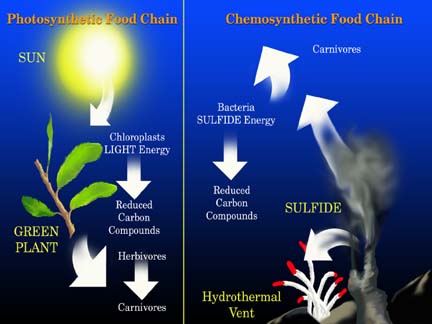Tuesday, April 10, 2012
Geology, Geography, Formation, and Chemosynthesis of Hydrothermal Vents (Chrissy and Lillie)
According to http://www.ceoe.udel.edu/deepsea/level-2/geology/vents.html, hydrothermal vents contribute to the regulation of the “ocean’s temperature, chemistry, and circulation patterns,” as well as the exchange of chemicals and heat that takes place between the ocean and Earth’s interior. In 1977, the exploration of the East Pacific Rise, a mid-ocean ridge located near the Galapagos, resulted in the discovery of hydrothermal vents. The majority of hydrothermal vents form along mid-ocean ridges at an average depth of 2100 m, and Woods Hole Oceanographic Institute has led a recent expedition to explore several new vent sites.
At mid-ocean ridges, magma beneath the Earth’s surface forms rift valleys as it pushes the tectonic plates away from each other. When the water enters these crevices it is heated by the magma, however kept from boiling by the extreme pressure. The density of this fluid then decreases, allowing it to rise up through the vent and absorb minerals. The differences in temperature of this fluid to the water surrounding it causes it to crystallize and form chimneys that an reach up the nine feet tall.
“Black smokers” are a distinct type of hydrothermal vent that form at the location of sulfide mounds and typically emit the hottest water. The black color of the fluid emitted from these hydrothermal vents is due to the presence of the compound iron monosulfide.
The characteristics of hydrothermal vents and their communities vary based on geographic location. On the rapidly-spreading mid-ocean ridges in the Pacific, the characteristics of the vent systems appear relatively uniform; however, slow-spreading ridges have a greater degree of diversity.
Along with heated water, minerals, and chemicals, hydrothermal vents also spew bacteria (called microbes) that play a crucial role in chemosynthesis, which is the production of food and energy from heat, chemicals (such as sulfur compounds), and methane by certain organisms.
The microbes perform chemosynthesis, releasing sulfur and water as end products while also providing a food source for larger organisms.
While black smokers release vast quantities of iron and sulfide (iron monosulfide), white smokers release colder water that contains barium, calcium, and silicon compounds.
Subscribe to:
Post Comments (Atom)





No comments:
Post a Comment